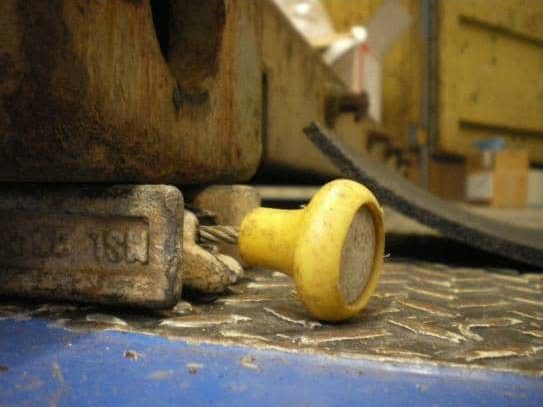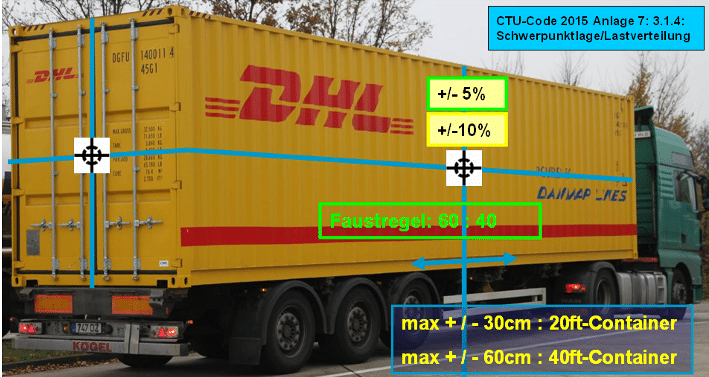
Now 10% off all Ergolash lashing straps save now! Voucher code: ergo10 | Valid until 31.05.2025
The container is often regarded as a transport box that can be used for anything. However, loads are stowed in the container for which it is not built at all. It therefore seems necessary to describe the properties of the container in addition to the technical standards and regulations.
As the container in its current form was invented in America, the dimensions are based on the American footprint. One foot (ft), divided into 12 inches, corresponds to 0.3048 m. This measurement is still used in many areas, e.g. in aviation (flight altitude), ammunition (caliber measurements) and container transport.
The original standard container had a width and height of 8 feet each. And later the length of 20 feet was added, resulting in the comparative dimension TEU (Twenty-foot Equivalent Unit ). Unit) for the size/capacity data of container ships.

As a result, there were some difficulties for European shippers because the decimal system (1 m = 100 cm) prevails here. This problem is represented by the Euro pallet because it does not fit easily into the container.
Container dimensions for type 22G1/42G1 or 25G1/45G1 (see table)
| 20″ foot | 40″ foot | 8″ | 8,6″ | 9,6″ | ||
| Length | Length | Width | Height | Height | Height | |
| Exterior | 6.058 | 12.192 | 2.438 | 2.438 | 2.591 | 2.896 |
| Inside | 5.867 | 11.998 | 2.330 | 2.197 | 2.350 | 2.655 |
| Door | 2.286 | 2.134 | 2.261 | 2.566 | ||
| Pole dancing | 10 mm |
It is important for the shipper to note that the door width and height differ from the inside dimensions, i.e. they are correspondingly smaller. The internal dimensions of refrigerated or insulated containers can also vary, depending on the structure of the insulation and the built-in refrigeration unit. If the container is to be stowed precisely, the specific internal dimensions must be requested from the container owner.
If only Euro pallets are to be stowed precisely, a special container is required. For example, the LEG1 type. This is because it is longer than the normal 40 ft container and the walls have flatter corrugations. The internal width of >2.40 m is thus achieved.

The construction of the container is designed to create a stable frame. This consists of the corner posts and the respective upper and lower cross beams.
The entire force transmission in the container stack takes place via the vertical corner posts. In addition, the connection between the containers on the ship also runs purely via the corner posts.

An important component, the corner casting, is welded to each end of the corner posts. Both above and below. The so-called twistlocks intervene in these corner castings. The twistlocks are installed on the means of transport and connect the container to the chassis of the truck or rail wagon.

The truck driver or railroad employee is responsible for opening or closing the twistlocks. Loose twistlocks are used to connect the containers to the stack on the ship’s deck. These must be snapped into the lower corner castings by hand.


This version of the twistlock locks automatically when the crane driver places the container on the stack.
When unloading, a lasher must pull the yellow bendel outwards from above with a long rod that grips it. This unlocks the twist lock and the crane driver can lift the container.

Locks are fitted to all four corners of the loading harness, the spreader. This allows the container to be lifted. To do this, the crane driver must hit all four corner castings in order to lock with one turn.
It often happens that he does not meet the corner castings. This causes damage to the container roof. This either creates a hole straight away or the dent becomes a hole due to rust.
From the inside, such damage often looks like the picture.
During the incoming goods inspection, the packer must ensure that the container is leak-proof by checking this area in particular at all four corners.

Cargo can be secured in the container not only positively but also non-positively .
Lashing points are required for non-positive securing. With the exception of refrigerated containers, all containers have so-called lashing points.
These are eyelets on the lower and upper side members. The eyelets on the floor are designed for a load of 1,000 daN at any angle. And the upper ones with 500 daN.


Lashing points are an alternative for refrigerated containers, as they can be inserted into the cooling fins and bolted in place.
Lashing straps can be pulled through eyelets for friction-locked securing. In the same way, a load unit can be blocked with the vertical edge.

It is important that the strengths of the container body are known and observed in order to secure the load positively. The structural strength always refers to a surface load.
The container is often damaged because inaccurately cut dunnage is used and point loads are transferred, especially to the container walls. The picture clearly shows the dents caused by dunnage in the upper third of the wall.


In quite a few cases, the authorities complain about incorrect load distribution in the container during inspections at the port.
If the inspectors see the adjacent congestion situation when opening the container, it is almost no longer necessary to make a calculation to recognize that the load distribution cannot be correct.

The CTU Code 2015, which replaces the old CTU packing guidelines from 1999, provides clear information on this. Responsibility is transferred to the packer/stacker.
The correct load distribution in the container also leads to the correct distribution of the axle loads on the truck. Incorrect stowing quickly leads to the permissible drive axle load being exceeded.

The center of gravity should therefore be transverse and below half the height of the container. Longitudinal deviations of +/-5%, in exceptional cases also +/-10% are permissible.
The rule of thumb 60:40, i.e. 60% of the load in one half of the container, is also permissible. However, particular attention must be paid to the possibility of exceeding the drive axle load if 60% of the load is stowed in the front half.

If an empty container is delivered, it is the shipper’s obligation to check it for suitability. But what needs to be considered? You will find out more about this in the next episode.
Yours, Sigurd Ehringer
<< Previous article
Episode 2: CSC badge and ACEP – explanation of abbreviations and inspection criteria
Next Post >>
Episode 4: Who is responsible for load securing?

Sigurd Ehringer
✔ VDI-zertifizierter Ausbilder für Ladungssicherung ✔ Fachbuch-Autor ✔ 8 Jahre Projektmanager ✔ 12 Jahre bei der Bundeswehr (Kompaniechef) ✔ 20 Jahre Vertriebserfahrung ✔ seit 1996 Berater/Ausbilder in der Logistik ✔ 44 Jahre Ausbilder/Trainer in verschiedenen Bereichen —> In einer Reihe von Fachbeiträgen aus der Praxis, zu Themen rund um den Container und LKW, erhalten Sie Profiwissen aus erster Hand. Wie sichert man Ladung korrekt und was sind die Grundlagen der Ladungssicherung? Erarbeitet und vorgestellt werden sie von Sigurd Ehringer, Inhaber von SE-LogCon.
Rothschenk assortment
Our customer center has only one goal: to turn your problems into solutions. Whether standard stowage cushions, bestsellers or load securing personally tailored to your needs -. we accompany you consistently from A as in field service to Z as in certification. That is our promise to you, as a leader in our industry.
We attach great importance to professional cargo securing. That is why we have our own production, which ensures reliable operation through modern manufacturing technologies and strict quality control. Thus, we offer our customers a comprehensive and high-quality range of services in the field of transport logistics.
DIN ISO 9001:2015, EMAS and Ecovadis are not foreign words to you? Then it's time to work with the best.
You don't take any risks with us - we have been awarded the Platinum Medal on the EcoVadis sustainability rating platform.
As a load securement company, we are proud to have several certifications that validate our sustainability efforts and our commitment to environmental protection and social responsibility. For you as a purchaser, this means that we demand and promote the implementation of high environmental and social standards both within the company and along the supply chain.
You are currently viewing a placeholder content from Google Maps. To access the actual content, click the button below. Please note that doing so will share data with third-party providers.
More Information